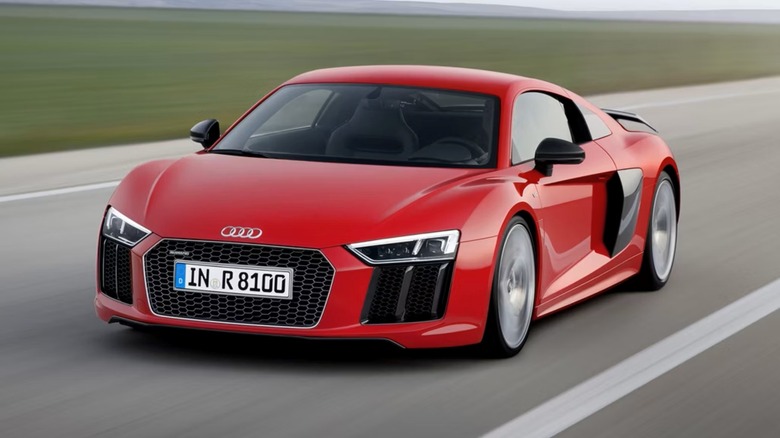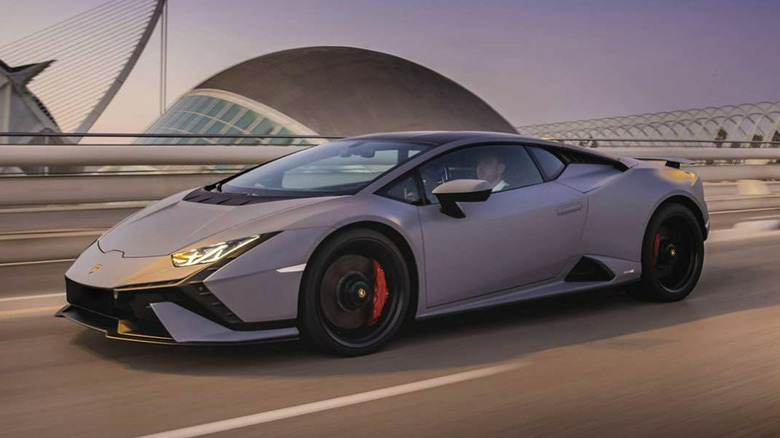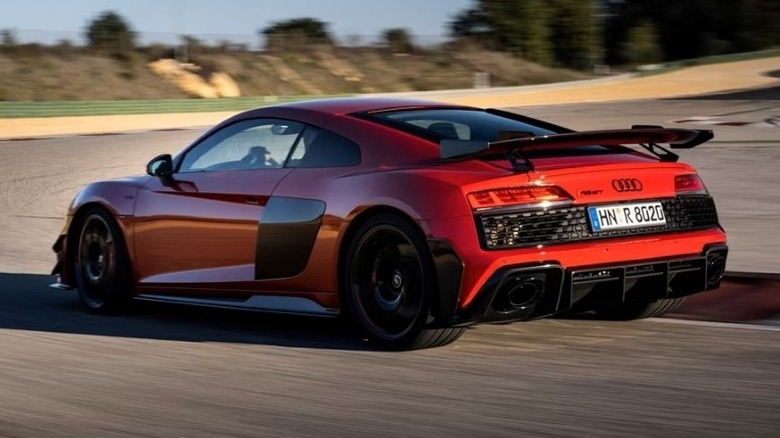Is The Audi R8 Really Returning In 2027?
Famed nameplates making a comeback after previously being discontinued is a familiar story that plays out repeatedly in the car industry. Now, following a two-year absence from American sales lots, it seems as though the Audi R8 could return to the sports car market in 2027. Reports suggest the R8 badge will be reintroduced as a plug-in hybrid based around the Lamborghini Temerario, and is expected to share chassis, drivetrain, and electric components with the Huracán successor.
For context, the Temerario currently employs a 4.0-liter twin-turbo V8 backed by three electric motors motivated by a 3.8 kWh lithium-ion battery pack to produce a staggering power of 907 total hp and 538 lb-ft of torque. This is funneled to all four wheels through an eight-speed dual-clutch automatic gearbox. If the Temerario is anything to go by, the new supercar will be extremely potent. According to reports, the upcoming Audi R8 will likely be released around the same time as higher-performance versions of the current Temerario, suggesting power outputs of around 1,000 horsepower could be on the cards.
In the event that this happens, it will make the new R8 the most powerful Audi model yet, eclipsing the Audi E-tron GT RS, which currently generates 912 horsepower. Given the numbers being peddled, the new Audi R8 could be capable of sprinting from zero-to-60 mph in under three seconds and a potential 210-mph top speed. Nothing is definite at this point, but with Audi chairman Gernot Döllner reportedly giving very strong backing to the R8's revival, it's safe to assume we'll be seeing the third-generation R8 in 2027. The new R8 will be offered in coupe and convertible forms, with potential rivals slated to include the Porsche 911 and Mercedes-AMG GT.
The nexus between the Audi R8 and Lamborghini runs deeper than the new R8
The idea of the Audi R8 and Lamborghini cars sharing parts isn't new. The first-generation R8 and the Lamborghini Gallardo LP560‑4 shared the same V10 engines, automated manual gearbox, aluminum chassis, and suspension components. Speaking with Car and Driver, an Audi engineer said the only difference between the Audi R8 and Gallardo "lies in intake and exhaust system, as well as the electronics."
However, as you'd expect given Lamborghini's higher standing under the Volkswagen umbrella, the R8 engine is less gutsy than the Gallardo's, with output rated at 525 hp and 391 lb-ft of torque, compared with 552 hp and 398 lb-ft for the Gallardo LP560‑4. For its second generation, the Type 4S R8 was paired with the Lamborghini Huracán, which succeeded the Gallardo. Both models used the same Modular Sports System platform, same 5.2-liter V10, seven-speed dual-clutch automatic transmission, and shared many other components.
Why was the Audi R8 discontinued?
While the Audi R8 — especially in V10 guise — was favored by enthusiasts and celebrities like Robert Downey Jr., the supercar was sold for just 17 years before being culled in 2024. Audi's decision to discontinue the R8 followed a sustained period of poor sales of the supercar, with the mid-engine two-seat sports car consistently selling under 2,000 units each year since 2019. That lackluster performance makes the R8 one of the slowest-selling cars in the world.
Unsurprising, slow sales of the Audi R8 have been attributed to its sky-high price tag, which puts it out of reach for many willing buyers. And, it's hard to argue with the fact. The original model had a starting sticker price of $109,000 for models with the six-speed manual and $118,000 for versions fitted with the six-speed R tronic (DSG) semi-automatic gearbox.
By its final model year, the R8's base msrp had climbed to $158,600 for the 562-hp R8 V10 performance Coupe RWD and $209,700 for the 602-hp R8 V10 performance Coupe quattro. This meant interested buyers needed very deep pockets to afford it. Low demand aside, the R8's discontinuation has been linked with Audi's intent to comply with emissions standards.


